Venezuela: Opposition march repressed with tear gas and buckshot
by Ramon Navarro and Laura Weffer
Translated by Francisco Toro, reprinted from El Nacional. Photos from Devil’s Poop.
CARACAS-“The order is to resist, resist,” said one lady close to 70 years of age to a group of friends who replied: “Today or never, Magdalena, you are right, we have to resist.” Around eight women were next to the security cordon placed by the CANTV headquarters on Libertador Avenue in Caracas, while the thick of the opposition march walked euphorically towards Plaza Morelos.
Suddenly, the National Guard responded to the citizen action with tear gas, for no other reason than the arrival of the march on territory that had been permitted by the competent authorities, but was banned turf to the military.

The ladies left at a jog, escaping the effects of the tear gas canisters, that scratched their faces generating an intolerable chaos as people retreated. And yet, they didn’t manage altogether to clean up the area, because the people would return to offer resistence, would return with anti-government slogans, would again inflame the patience of the so-called “guards at the service of the regime.”
The march, called by the opposition and whose ultimate goal was to reach Plaza Morelos, did not meet its main goal: to get noticed by the foreign ministers and some heads of state from the Group of 15, who were meeting in the Teresa Carreno Theater.
Burning
At 8:30 am, people started to arrive at Parque del Este, on the main Francisco de Miranda avenue, starting point for the protest. Copei and MAS representatives were the first to prepare their flags, while Primero Justicia joined in Altamira, Proyecto Venezuela in Chacaito and AD in La Florida.
The spirit of the march was to break through the security barrier and reach the space adjacent to the theater. On that subject organizer Oscar Perez spoke clearly about the legitimate right to reach the space accorded: “We have authorization from the Greater Caracas mayor, and I don’t see why they want to stop this peaceful march.”
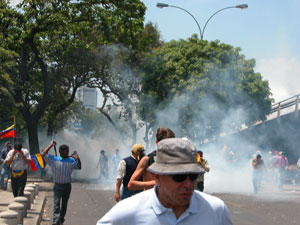
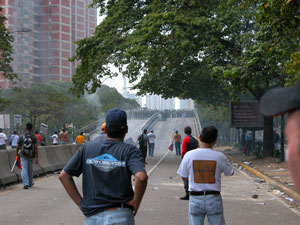
Opposition leaders like Lilieana Hernandez, Henry Ramos Allup, Miranda state governor Enrique Mendoza, Gerardo Blyde, Jesus Mendez Quijada, Carlos Ocariz, among others, went through the rigors of inhaling large doses of tear gas, surprised also by the military show of force, though the soldiers (the “soldiers” are National Guard troops -ft) were also attacked with bottles, sticks, and stones.
Some of the tear gas canisters ended up against the walls of the Lara and Zulia residential buildings, on Libertador Avenue, and others were directed to the parking lot in front of the El Globo newspaper, and others never even came close to the protesters. This shows not just the spotty marksmanship but the real sense of dissuasion of the guarantors of public order.
However, there were also dozens of canisters shot into the heart of the march, whose protagonists started throwing stones at the MVR party building, while one person, unidentified, set fire to the roof of a neighboring car garage.

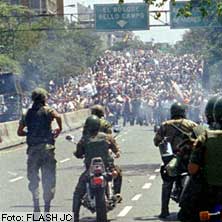
“If you want to topple Chavez then shit, ignore him! They almost burned my house. People live here, that crap is not on. They burned the roof of my house and they almost burned my truck. In this garage there are flamable materials,” said an angry Juan Carlos Calderon, co-owner of the shop, who came out half-naked to yell for help.
In fact, the same people who tried to burn down the place later bashfully helped to put out the fire.
Also in Plaza Venezuela, a man of 60 or so was shot in the leg, “they hit me! they hit me!” and while he asked for help from the metropolitan fire department, a crowd of people in AD flags charged a wooden structure and threw everything out onto the street, including bottles.
Just before that, a rattle of gunfire forced over 300 people in Plaza Venezuela to fall to the ground.
All out
The wall of tear gas didn’t allow one to see through to the other side. The green uniforms could be seen tenuously behind the choking white mass. Suddenly, as though in a fiction film, groups of women and men with flags in their hands would expose themselves to the irrepressible effects of the gas.
Regardless of age or gender, people would face down the charges of the guards. At the compressed cry of “pa’lante!” (“onward!”) the protesters would push forward, gaining meter by meter terrain from the military men.

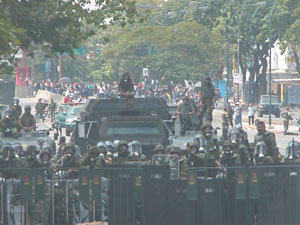
But victory was short. In a well rehearsed syncronicity, the uniformed men would fire off canisters and rubber buckshot to anyone they saw defending the tricolor flag. The opposition members would resist a few seconds, minutes at most, but then had to retreat because the gas did not allow them to breathe.
“If you’re going to kill us, then kill us” screamed one of the marchers, with bloodshot eyes and sweating buckets. From the loudspeakers, eventually, a voice tried to convince the marchers to walk back, but the will of the people was not seduced by the call.
Beneath the Mariperez overpass, those in the vanguard made a deafening noise. With anything they could get their hands on they would strike the metal bases of the bridge, building a strong echo. An amazing noise.
Aura Morales, 74 years old, refused to walk backwards. She remembered the way she had faced down the national security (the dictatorship era security force in the 50s), in the times of the Perez Jimenez dictatorship “and in that time they had machine guns.”
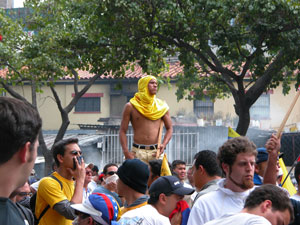
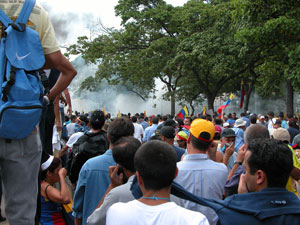
With a discrete cap and a flag in her hand, she refused to answer the call of those calling on her to retreat. “For god’s sake! Always go backward!” and with nostalgia she would look on the few meters they had conquered and that again the military were recovering. A bit further on, a small man, some 70 years old, was screaming at the top of his lungs, and with a stone in his hand said he was foreign, but he was going to defend Venezuela because he considered it his fatherland.
At 1:35 pm, the Guardia had already lost all inhibitions and was firing bursts of buckshot, and some of the marchers would fire back with roman candles. With the National anthem in the background, people refused to back down. One of the women who had to be evacuated, passed out, returned later with her flag and walked back into the tear gas.
Shots
The dry sound of a hand gun broke with the buckshot chorus, which had already become an auditive routine. From the street in front of the Patria Para Todos headquarters, behind the Main Street in Mariperez, a group of youths was shooting upward, exactly in the direction of the bridge, on Libertador avenue.
The protesters responded with stones, most dropped to the ground in a split-second reaction. Some covered their heads, others stayed totally still. Nobody screamed. In the distance, the figure of a young man could be seen at the door of his house, doing what he could to try to stop the exchange.
A few minutes later, people returned to their struggle. To the skirmishes with the military. Chanting slogans and breathing tear gas. In the mean time, the Disip secret police helicopter flew over the area. The response of those below was to raise their middle finger in the “usual gesture.”
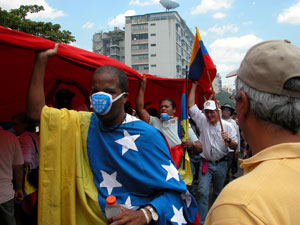
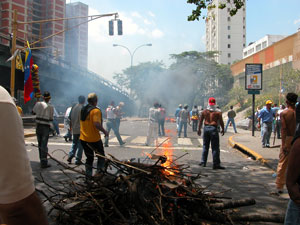
By 2:35 pm the uniformed men went back on the offensive. Protected by untold tear gas canisters, they advanced and advanced until they dissolved the last of the rally. Thus, they took the neighboring areas and some spots that had served as opposition regrouping areas. Some ran for the side streets. On Lima Sur street, the protesters took shelter for a while in the student bar, Cordon Bleu. By 3:20 pm what had been a battle field turned into a desolate field for firing tear gas canisters.
Below, on Plaza Venezuela, the Guards had cordoned off the area. Already resting from their attack, they were replenishing themselves eating hot dogs from the “Taliban” stand, and drinking kolitas. They traded stories about the day, laughing, as though it had been just one more victory.
Caracas Chronicles is 100% reader-supported.
We’ve been able to hang on for 22 years in one of the craziest media landscapes in the world. We’ve seen different media outlets in Venezuela (and abroad) closing shop, something we’re looking to avoid at all costs. Your collaboration goes a long way in helping us weather the storm.
Donate




